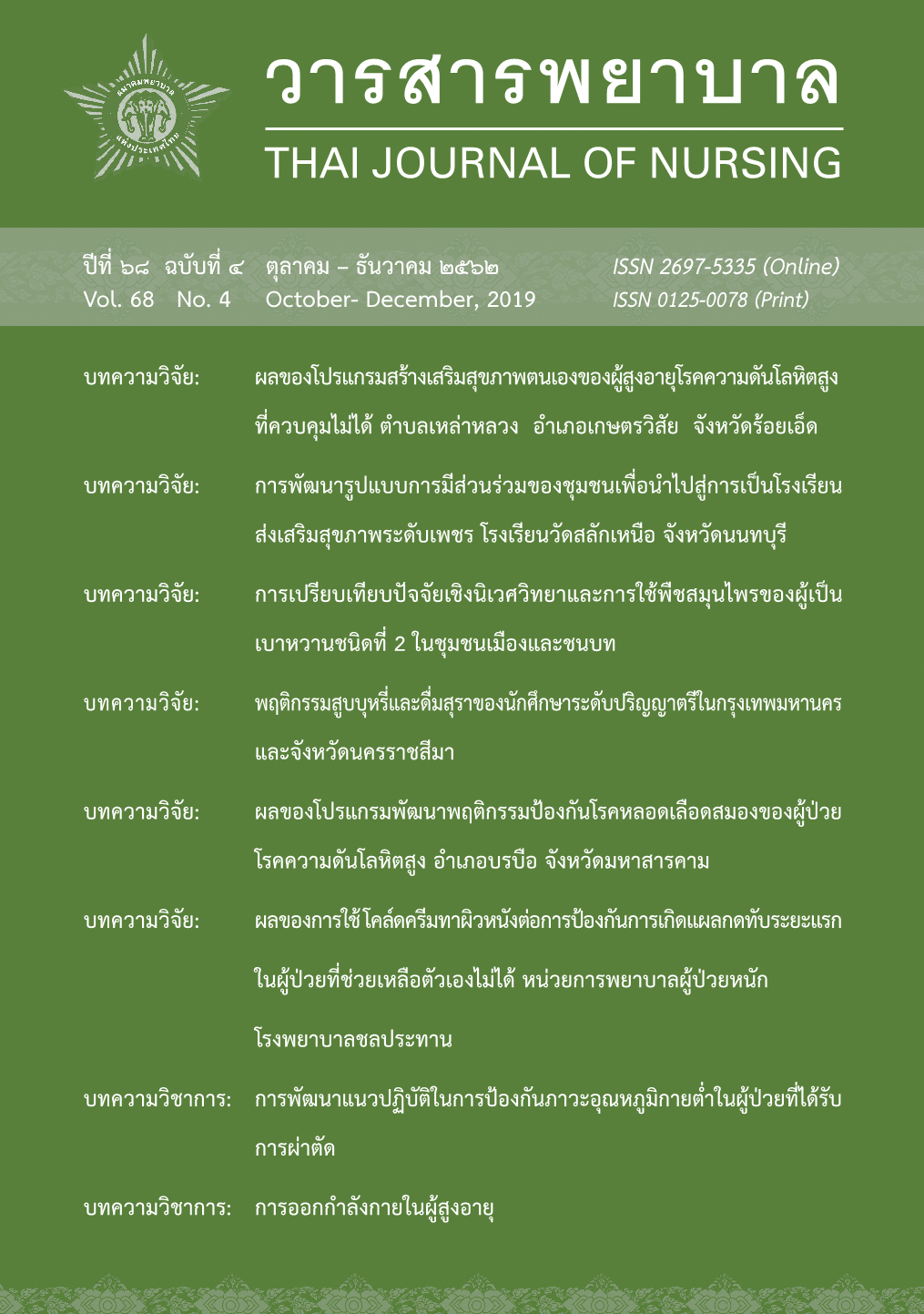Comparison of ecological factors and herbal use in persons with type 2 Diabetes Mellitus between urban and rural communities
Main Article Content
Abstract
This descriptive study aimed to compare ecological factors and herbal use in persons with type 2 diabetes mellitus between urban and rural communities. The participants included 300 persons with type 2 diabetes mellitus, were purposively selected. Bronfenbrenner’s Ecological Model was used to guide the conceptual framework of this study. Instruments included demographic questionnaire, herbal use questionnaire, health literacy questionnaire, self-care behaviors questionnaire, and social support in persons with type 2 diabetes mellitus questionnaire. Data were analyzed using Mann-Whitney U test and Chi–square test. Results revealed as follows. 1) There were no significant differences in overall health literacy and subscales including functional, interactive and critical parts, social support, and herbal use in people with type 2 diabetes mellitus between urban and rural communities (p > .05). 2) Self-care behaviors in total and foot care and hygiene subpart, had significant differences (p < .05). 3) Self-care behaviors in the subparts of exercise, food consumption behaviors and medication taking were not significantly different (p > .05).
Article Details
References
กระทรวงสาธารณสุข กลุ่มงานอายุรศาสตร์โรงพยาบาลราชวิถี. (2557). การดูแลผู้ป่วยโรคเบาหวานที่ยาก
ต่อการรักษา. กรุงเทพมหานคร: ผู้แต่ง.
กระทรวงสาธารณสุข คณะกรรมการอำนวยการจัดทำแผนพัฒนาสุขภาพแห่งชาติ ฉบับที่ 12. (2555).
แผนพัฒนาสุขภาพแห่งชาติ ฉบับที่ 12 (พ.ศ. 2560-2564). นนทบุรี: ผู้แต่ง.
จารุวรรณ ศรีสร้อย. (2555). ปัจจัยที่มีความสัมพันธ์กับพฤติกรรมการใช้สมุนไพรรักษาโรคของประชาชน
ในเขต 11 กระทรวงสาธารณสุข. วารสารเกื้อการุณย์, 19(2), 60-74.
มูลนิธิหมอชาวบ้าน. (2559). สมุนไพรรักษาเบาหวาน. สืบค้นเมื่อ 16 มกราคม 2559, จาก
https://www.doctor.or.th/article/detail/11212.
วงศ์สถิตย์ ฉั่วกุล, และอรัญญา ศรีบุศราคัม. (2551). จุลสารข้อมูลสมุนไพร มหาวิทยาลัยมหิดล, 25(4).
-49.
วิชัย เอกพลากร. (2553). การสำรวจสุขภาพประชาชนไทยโดยตรวจร่างกายครั้งที่ 5 พ.ศ.2557.
นนทบุรี: เดอะกราฟิโก ซิสเต็มส์ .
วิภา อุทยานินทร์, เสาวนันท์ บำเรอราช, และกาญจนา นิ่มสุนทร. (2556). พฤติกรรมการใช้สมุนไพรใน การ
ลดระดับน้ำตาลในเลือดของผู้ป่วยเบาหวาน: ข้อมูลพื้นฐานเพื่อนำไปสู่การพัฒนาระบบบริการ
เบาหวานในอำเภอห้วยแถลง. วารสารการพัฒนาสุขภาพชุมชนหาวิทยาลัยขอนแก่น, 1(1), 11-24.
วิไลวรรณ ชัยณรงค์. (2554). ปัจจัยที่มีความสัมพันธ์กับพฤติกรรมการใช้สมุนไพรเพื่อการรักษาเบื้องต้น
ของประชาชน ในเขตอำเภอธัญบุรี จังหวัดปทุมธานี. (วิทยานิพนธ์ปริญญามหาบัณฑิต ไม่ได้ตีพิมพ์).
มหาวิทยาลัยเกษตรศาสตร์, กรุงเทพมหานคร.
Bronfenbrenner, U. (Ed.). (2005). Making human beings human bioecological perspectives on human
development. Thousand Oaks, CA: Sage.
Damnjanovic, I., Kitic, D., Stefanovic, N., Zlatkovic-Guberinic, S., Catic-Djordjevic, A.,
Velickovic, R., & Radovanovic, R. (2015). Herbal self-medication use in patients with diabetes
mellitus type 2. Turkish Journal of Medical Sciences, 45(4), 964-971.
Hinder, S., & Greenhalgh, T. (2012). “This does my head in “ Ethnographic study of self-management by
people with diabetes. BMC Health Services Research, 12(1), 83.
Ishikawa, H., & Yano, E. (2008). Patient health literacy and participation in the health-care process.
Health Expect, 11(2), 113-122.
Keeratiyutawong, P. (2005). Effectiveness of a self-management program for Thais with type 2
diabetes. Thai Journal of Nursing Research, 10(2), 85-89.
Maneesriwongul, W., & Dixon, J. K. (2004). Instrument translation process: A methods review. Journal
of Advanced Nursing, 48(2), 175-186.
Paramanick, D., & Sharma, N. (2017). A review on herbs which are used in Diabetes Mellitus.
International Journal of Drug Development and Research, 9, 12-17.


